各校语言学考博真题
语言学理论考博试题
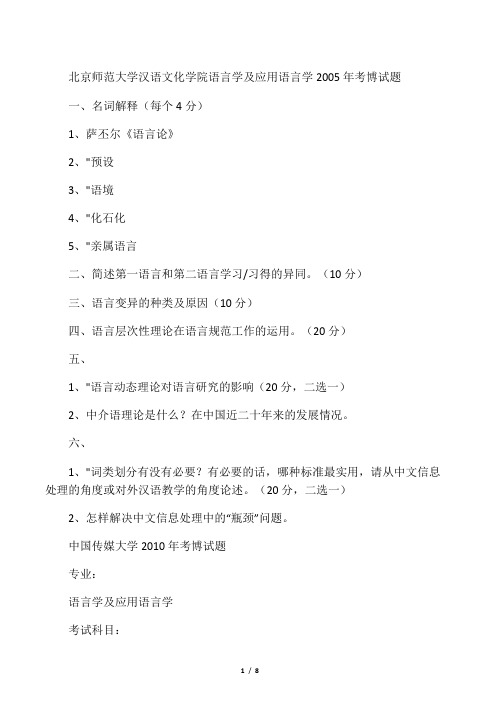
北京师范大学汉语文化学院语言学及应用语言学2005年考博试题一、名词解释(每个4分)1、萨丕尔《语言论》2、"预设3、"语境4、"化石化5、"亲属语言二、简述第一语言和第二语言学习/习得的异同。
(10分)三、语言变异的种类及原因(10分)四、语言层次性理论在语言规范工作的运用。
(20分)五、1、"语言动态理论对语言研究的影响(20分,二选一)2、中介语理论是什么?在中国近二十年来的发展情况。
六、1、"词类划分有没有必要?有必要的话,哪种标准最实用,请从中文信息处理的角度或对外汉语教学的角度论述。
(20分,二选一)2、怎样解决中文信息处理中的“瓶颈”问题。
中国传媒大学2010年考博试题专业:语言学及应用语言学考试科目:理论语言学考试时间:2010年3月27日14:00—17:00一.请就语言规划或语言规范化研究尽你所知展开论述。
(40分)二.以下两题任选一道作答。
(30分)A.请论述话语(语篇或篇章)的研究。
B.论述形式主义语言学与功能主义语言学的区别。
三.分析题。
(3×10分=30分)1.请分析下面三个四字格短语的联系,并分析造成这种区别的原因以及每个短语的表达效果。
喜鹊登枝、喜上梅梢、喜上眉梢2.请从认知的角度解释为什么“我后悔死这件事了”能变换为“这件事后悔死我了”,而“我后悔这件事”不能变换成“这件事后悔我了”?3.运用预设理论分析下面这句话:北京又开始打击非法一日游了。
考试科目:应用语言学的历史及理论考试时间:2010年3月28日8:30—11:30(第1题为必答题,2、"3、4题中任选两道作答。
)1.请论述学习和研究应用语言学历史的主要意义和方法。
(40分)2.请结合汉语史著作论述语言文字对于社会的应用。
(30分)3.请论述语言学中预测方法。
(30分)4.请论述结构语言学与社会语言学的歧异。
(30分)北京师范大学汉语文化学院09年博士入学专业试题在水中央出自:为学浏览/评论:39/0日期:2010年5月9日15:34现代汉语及古代汉语一、(1、"2选一3、"4选一)1、简述语言学和音位学的区别。
华师考博试题汇总
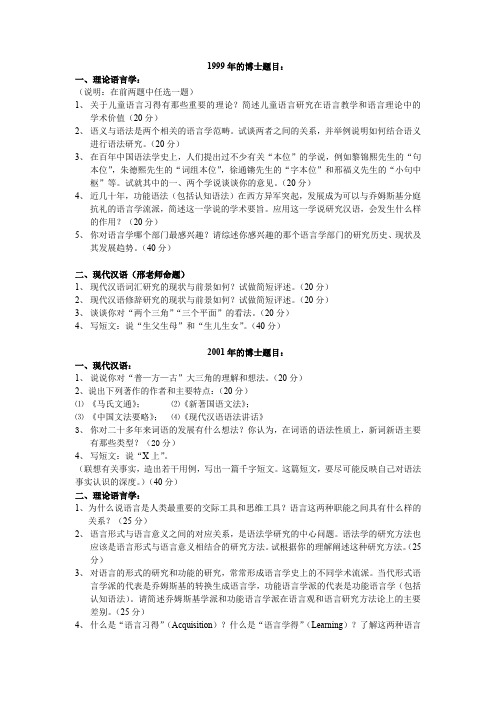
1999年的博士题目:一、理论语言学:(说明:在前两题中任选一题)1、关于儿童语言习得有那些重要的理论?简述儿童语言研究在语言教学和语言理论中的学术价值(20分)2、语义与语法是两个相关的语言学范畴。
试谈两者之间的关系,并举例说明如何结合语义进行语法研究。
(20分)3、在百年中国语法学史上,人们提出过不少有关“本位”的学说,例如黎锦熙先生的“句本位”,朱德熙先生的“词组本位”,徐通锵先生的“字本位”和邢福义先生的“小句中枢”等。
试就其中的一、两个学说谈谈你的意见。
(20分)4、近几十年,功能语法(包括认知语法)在西方异军突起,发展成为可以与乔姆斯基分庭抗礼的语言学流派,简述这一学说的学术要旨。
应用这一学说研究汉语,会发生什么样的作用?(20分)5、你对语言学哪个部门最感兴趣?请综述你感兴趣的那个语言学部门的研究历史、现状及其发展趋势。
(40分)二、现代汉语(邢老师命题)1、现代汉语词汇研究的现状与前景如何?试做简短评述。
(20分)2、现代汉语修辞研究的现状与前景如何?试做简短评述。
(20分)3、谈谈你对“两个三角”“三个平面”的看法。
(20分)4、写短文:说“生父生母”和“生儿生女”。
(40分)2001年的博士题目:一、现代汉语:1、说说你对“普—方—古”大三角的理解和想法。
(20分)2、说出下列著作的作者和主要特点:(20分)⑴《马氏文通》;⑵《新著国语文法》;⑶《中国文法要略》;⑷《现代汉语语法讲话》3、你对二十多年来词语的发展有什么想法?你认为,在词语的语法性质上,新词新语主要有那些类型?(20分)4、写短文:说“X上”。
(联想有关事实,造出若干用例,写出一篇千字短文。
这篇短文,要尽可能反映自己对语法事实认识的深度。
)(40分)二、理论语言学:1、为什么说语言是人类最重要的交际工具和思维工具?语言这两种职能之间具有什么样的关系?(25分)2、语言形式与语言意义之间的对应关系,是语法学研究的中心问题。
清华大学人文学院外国语言文学专业应用语言学与语言教育历年考博真题经验分享-育明考博
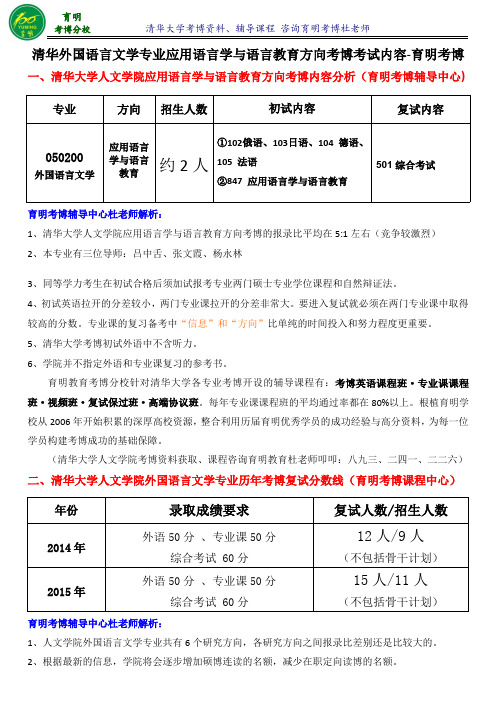
清华外国语言文学专业应用语言学与语言教育方向考博考试内容-育明考博一、清华大学人文学院应用语言学与语言教育方向考博内容分析(育明考博辅导中心)专业方向招生人数初试内容复试内容050200外国语言文学应用语言学与语言教育约2人①102俄语、103日语、104德语、105法语②847应用语言学与语言教育501综合考试育明考博辅导中心杜老师解析:1、清华大学人文学院应用语言学与语言教育方向考博的报录比平均在5:1左右(竞争较激烈)2、本专业有三位导师:吕中舌、张文霞、杨永林3、同等学力考生在初试合格后须加试报考专业两门硕士专业学位课程和自然辩证法。
4、初试英语拉开的分差较小,两门专业课拉开的分差非常大。
要进入复试就必须在两门专业课中取得较高的分数。
专业课的复习备考中“信息”和“方向”比单纯的时间投入和努力程度更重要。
5、清华大学考博初试外语中不含听力。
6、学院并不指定外语和专业课复习的参考书。
育明教育考博分校针对清华大学各专业考博开设的辅导课程有:考博英语课程班·专业课课程班·视频班·复试保过班·高端协议班。
每年专业课课程班的平均通过率都在80%以上。
根植育明学校从2006年开始积累的深厚高校资源,整合利用历届育明优秀学员的成功经验与高分资料,为每一位学员构建考博成功的基础保障。
(清华大学人文学院考博资料获取、课程咨询育明教育杜老师叩叩:八九三、二四一、二二六)二、清华大学人文学院外国语言文学专业历年考博复试分数线(育明考博课程中心)育明考博辅导中心杜老师解析:1、人文学院外国语言文学专业共有6个研究方向,各研究方向之间报录比差别还是比较大的。
2、根据最新的信息,学院将会逐步增加硕博连读的名额,减少在职定向读博的名额。
年份录取成绩要求复试人数/招生人数2014年外语50分、专业课50分综合考试60分12人/9人(不包括骨干计划)2015年外语50分、专业课50分综合考试60分15人/11人(不包括骨干计划)3、初试英语拉开的分差较小,两门专业课拉开的分差非常大。
北外语言学考博试题四

北京外国语大学中国外语教育研究中心2008年博士生招生考试试卷(A卷)(刘润清)Directions: Answer any FOUR of the following questions, each bearing 25 points out of 100. Your answers will be evaluated in terms of both theircontent and Ian guage. Please write very clearly.I Define TEN of the followi ng terms and the n tran slate them into Chin ese.I.register 2. dialect 3. li nguistic pote ntial 4. critical period hypothesis5. displaceme nt6. duality of structure7. extrapositi on8. gradual adjective9. deducti on 10. idiolect 11. lateralizatio n 12. retrospect ion13. pho neme 14. right branching direct ion 15. rule-gover ned behavior16. speech syn thesis 17. behaviourism 18. null operator moveme nt19. story grammar 20. traditi onal grammarII.Read carefully the followi ng passage take n from Saussure ' Course in GeneralLinguistics and then discuss its importanee in exploring the nature of Ian guage.Lan guage is a system of sig ns that express ideas, and is therefore comparable to a system of writing, the alphabet of deaf-mutes, symbolic rites, polite formulas, military signals, etc. But it is the most importa nt of all these systems.A scie nce that studies the life of sig ns within society is con ceivable; it would be a part of social psychology and con seque ntly of gen eral psychology; I shall call it semiology. Semiologywould show what con stitutes sig ns, what laws gover n them. Since the scie nce does not yet exist, no one can say what it would be; but it has a right to existence, a place staked out in advance. Linguistics is only a part of the general science of semiology; the laws discovered by semiology will be applicable to linguistics, and the latter will circumscribe a well-defined area within the mass of an thropological facts.To determine the exact place of semiology is the task of the psychologist. The task of the lin guist is to find out what makes Ian guage a special system with in the mass of semiological data. This issue will be taken up again later; here I wish merely to call attention to one thing: if I have succeeded in assigning linguistics a place among the science, it is because I have related it to semiology.III.The following passage is taken from Halliday ' An Introduction to FunctionalGrammar. Read it carefully, expla in what every sentence mea ns and the n comme nt on his theory of Ian guage.The basic oppositi on, in grammars of the sec ond half of the twen tieth cen tury, is not that betwee n 'structuralist' and 'generative' as set out the public debates of the 1960s.There are manyvariables in the way grammars are written, and any clustering of these is bound to distort the picture; but the more fundamental opposition is between those that are primarily syntagmatic in orientation (by and large the formal grammars, with their roots in logic and philosophy) and those that are primarily paradigmatic (by and large the functional ones, with their roots in rhetoric and ethnography) The former interpret a language as a list of structures, among which, as a distinct second step, regular relationships may be established (hence the introduction of transformations); they tend to emphasize universal features of language, to take grammar (which they call syntax) as the foundation of language (hence the grammar is arbitrary), and so to be organized around the sentence. The later interpret a language as a network of relations, with structurescoming in as the realization of these relationships; they tend to emphasize variables among differentlanguages, to take semantics as the foundation (hence the grammar is natural) and so to be organized around the text, or discourse, There are many cross-currents, with insights borrowed from one to the other; but they are ideologically fairly different and it is often difficult to maintain a dialogue.IV.The following passage is take from Peter Barb's Word Play: What Happens When People Talk (1973). Read it carefully and then comment on linguistic relativity.Such a connection between language and thought is rooted in common-sense beliefs, but no one gave much attention to the matter before Wilhelm von Humboldt, the 19th century German philologist and diplomat. He statedthat the structure of a language expresses the inner life of its speakers: "Man lives with the world abut him, principally, indeed exclusively, as language presents it." In this century, the case for a close relationship between language and reality was stated by Edward Sapir: "Human beings d not live in the objective world alone, nor alone in the world of social activity as ordinarily understood, but are very much at the mercy of the particular Ianguage which has become the medium for their society. The fact of the matter is that the 'real world' is to a large extent built up on the language habits of the group. No two languages are ever sufficiently similar to be considered as representing the same social reality. The worlds in which different societies live are distinct worlds, not merely the same world with different labels attached."About 1932 one of Sapir's students at Yale, Benjamin Lee Whorf, drew on Sapir's ideas and began an intensive study of the language of the Hopi Indians of Arizona. Whorf's brilliant analysis of Hopi places common-sense beliefs about language and thought on a scientific basis -- and it also seemed to support the view that man is a prisoner of his language. Whorf concluded that language "is not merely a reproducing instrument for voicing ideas but rather is itself the shaper of ideas. … we dissect nature along lines laid down by ourartive Ianguages."V.Please give the main content of Grice's Cooperative Principle with its four maxims explained and then discuss conversational implicatures of Group A (in which no maxim is violated), Group B (in which a maxim is violated), and Group C (in which a maxim is flouted by means ofa figure of speech).VI.The following is a passage by Chomsky. Read it carefully and then discuss th e difference between Chomsky's theory of linguistics and other approaches in linguistics.Generative grammar arose in the context of what is often called “the cognitive revolutionthe 1950s, and was an important factor in its development. Whether or not the term“ revol uappropriate, there was an important change of perspective: from the study of behavior and its products (such as texts), to the inner mechanisms that enter into thought and action. The cognitive perspective regards behavior and its products not as the object of inquiry, but as data that may provide evidence about the inner mechanisms of mind and the ways these mechanisms operate in executing actions and interpreting experience. The properties and patterns that were the focus of attention in structural linguistics find their place, but as phenomena to be explained along with innumerable others, in terms of the inner mechanisms that generate expressions. The approach is“ mentalistic, ” but in what should be an uncontroversial sense. It is concerned with “m of the world, ”which stand alongside its mechanical, chemical, optical, and other aspects. It undertakes to study a real object in the natural world —the brain, its states, and its functions —and thus to move the study of the mind toward eventual integration with the biological science.(Chomsky, N. 2000. New Horizons in the Study of Language and Mind)VII.The following is taken from Bloomfield's Language about the famous story of Jack and Jill which is often quoted to illustrate Bloomfield's behaviorism inlinguistics. Read it carefully and discuss how Bloomfield explains the process of stimulus and response and point out where he is wrong.Suppose that Jack and Jill are walking down a lane. Jill is hungry. She sees an apple in a tree. She makes a noise with her larynx, tongue and lips. Jack vaults the fence, climbs the tree, take the apple, brings it to Jill, and places it in her hand. Jill eats the apple.This succession of events could be studies in many ways, but we, who are studying language, will naturally distinguish between the act of speech and the other occurrences, which we shall call practical events . Viewed in this way, the incident consists of three parts in order of time:A.Practical events preceding the act of speech.B.Speech.C.Practical events following the act of speech.We shall examine first the practical events: A and C. The events in A concern mainly the speaker, Jill. She was hungry; that is, some of her muscles were contracting, and some fluids were being secreted, especially in her stomach. Perhaps she was also thirsty; her tongue and throat were dry. The light-waves reflected from the red apple struck her eyes. She saw Jack by her side. Her past dealings with Jack should now enter into the picture; ket us suppose that they consisted in some ordinary relation, like that of brother and sister or that of husband and wife. All these events, which precede Jill's speech and concern her, we call the speaker's stimulus.We now turn to C, the practical events which came after Jill's speech. These concern mainly the hearer, Jack, and consist of his fetching the apple and giving it to Jill. The practical events which follow the speech and concern the hearer, we call the hearer's response. The events which follow the speech concern also Jill, and this in very important way: she gets the apple into hergrasp and eats it.。
各校语言学考博真题
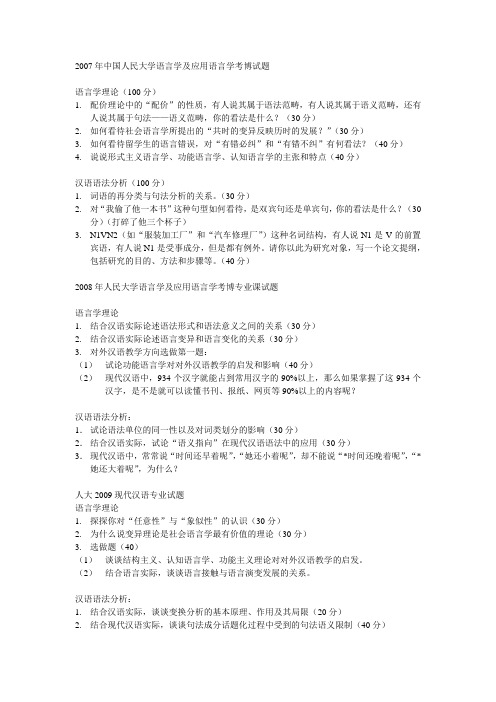
2007年中国人民大学语言学及应用语言学考博试题语言学理论(100分)1.配价理论中的“配价”的性质,有人说其属于语法范畴,有人说其属于语义范畴,还有人说其属于句法——语义范畴,你的看法是什么?(30分)2.如何看待社会语言学所提出的“共时的变异反映历时的发展?”(30分)3.如何看待留学生的语言错误,对“有错必纠”和“有错不纠”有何看法?(40分)4.说说形式主义语言学、功能语言学、认知语言学的主张和特点(40分)汉语语法分析(100分)1.词语的再分类与句法分析的关系。
(30分)2.对“我偷了他一本书”这种句型如何看待,是双宾句还是单宾句,你的看法是什么?(30分)(打碎了他三个杯子)3.N1VN2(如“服装加工厂”和“汽车修理厂”)这种名词结构,有人说N1是V的前置宾语,有人说N1是受事成分,但是都有例外。
请你以此为研究对象,写一个论文提纲,包括研究的目的、方法和步骤等。
(40分)2008年人民大学语言学及应用语言学考博专业课试题语言学理论1.结合汉语实际论述语法形式和语法意义之间的关系(30分)2.结合汉语实际论述语言变异和语言变化的关系(30分)3.对外汉语教学方向选做第一题:(1)试论功能语言学对对外汉语教学的启发和影响(40分)(2)现代汉语中,934个汉字就能占到常用汉字的90%以上,那么如果掌握了这934个汉字,是不是就可以读懂书刊、报纸、网页等90%以上的内容呢?汉语语法分析:1.试论语法单位的同一性以及对词类划分的影响(30分)2.结合汉语实际,试论“语义指向”在现代汉语语法中的应用(30分)3.现代汉语中,常常说“时间还早着呢”,“她还小着呢”,却不能说“*时间还晚着呢”,“*她还大着呢”,为什么?人大2009现代汉语专业试题语言学理论1.探探你对“任意性”与“象似性”的认识(30分)2.为什么说变异理论是社会语言学最有价值的理论(30分)3.选做题(40)(1)谈谈结构主义、认知语言学、功能主义理论对对外汉语教学的启发。
新编川大语言学考博真题(供参考)
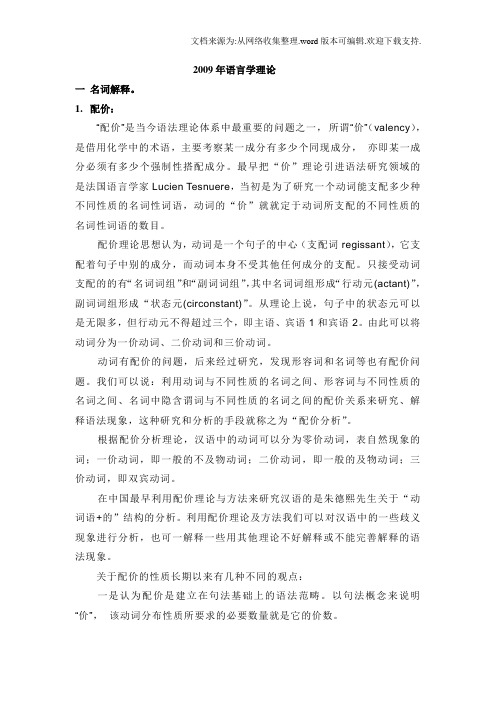
2009年语言学理论一名词解释。
1.配价:“配价”是当今语法理论体系中最重要的问题之一,所谓“价”(valency),是借用化学中的术语,主要考察某一成分有多少个同现成分,亦即某一成分必须有多少个强制性搭配成分。
最早把“价”理论引进语法研究领域的是法国语言学家Lucien Tesnuere,当初是为了研究一个动词能支配多少种不同性质的名词性词语,动词的“价”就就定于动词所支配的不同性质的名词性词语的数目。
配价理论思想认为,动词是一个句子的中心(支配词regissant),它支配着句子中别的成分,而动词本身不受其他任何成分的支配。
只接受动词支配的的有“名词词组”和“副词词组”,其中名词词组形成“行动元(actant)”,副词词组形成“状态元(circonstant)”。
从理论上说,句子中的状态元可以是无限多,但行动元不得超过三个,即主语、宾语1和宾语2。
由此可以将动词分为一价动词、二价动词和三价动词。
动词有配价的问题,后来经过研究,发现形容词和名词等也有配价问题。
我们可以说:利用动词与不同性质的名词之间、形容词与不同性质的名词之间、名词中隐含谓词与不同性质的名词之间的配价关系来研究、解释语法现象,这种研究和分析的手段就称之为“配价分析”。
根据配价分析理论,汉语中的动词可以分为零价动词,表自然现象的词;一价动词,即一般的不及物动词;二价动词,即一般的及物动词;三价动词,即双宾动词。
在中国最早利用配价理论与方法来研究汉语的是朱德熙先生关于“动词语+的”结构的分析。
利用配价理论及方法我们可以对汉语中的一些歧义现象进行分析,也可一解释一些用其他理论不好解释或不能完善解释的语法现象。
关于配价的性质长期以来有几种不同的观点:一是认为配价是建立在句法基础上的语法范畴。
以句法概念来说明“价”,该动词分布性质所要求的必要数量就是它的价数。
二是认为配价是语义平面的概念,提出的谓词的配价是以谓词的意义为基础的,谓词的意义决定了与之同现的必要成分。
北京师范大学外国语言文学学院应用语言学考博真题-参考书-分数线-分析资料-复习方法-育明考博

北京师范大学外国语言文学学院应用语言学考博指导与分析一、北京师范大学外国语言文学学院考博资讯北京师范大学外国语言文学学院的课程与教学论专业初试的两门专业课均用英文答题其余的见下文。
(一)考试科目及各方向导师:5.050211外国语言学及应用语言学研究方向01:应用语言学。
导师是罗少茜。
考试的科目:(1)1113二外(日语)或1114二外(法语)(100%)。
(2)2018普通语言学(100%)。
(3)3103应用语言学(100%)。
(二)复试分数线:1.复试原则与分数线:此分数线是各专业的最低复试/录取分数要求。
只适用于报考普通博士生、高校辅导员在职攻读思想政治教育专业博士学位研究生、高校思想政治理论课教师在职攻读马克思主义理论博士学位研究生的考生,不适用于少数民族高层次骨干人才攻读博士学位研究生和对口支援西部地区高等学校定向培养博士学位研究生。
未组织复试的导师,将在此分数线基础上,按照一定比例确定复试名单,并在4月中旬前组织复试,具体复试名单由报考院系通过院系网站或电话告知。
已经复试的导师,将在此分数线基础上,依据录取规则,按顺序录取。
专业代码及名称外国语业务课一业务课二总分050211外国语言学及应506060180用语言学2.复试方案:复试将对考生科研及实践经验、学术潜力、实践能力、综合素质等进行全面考查。
复试形式为面试,考生需参加两个小组的面试。
实践组(复试一组):重点考察考生实践经验及实践能力、实践案例分析。
考生进场后,自我陈述3分钟左右,然后回答案例问题,考官提问。
科研组(复试二组):重点考察考生科研经验及科研能力、研究选题计划、综合素质。
考生进场后,陈述研究选题计划3分钟后,考官提问。
复试满分值为200分,每小组满分各为100分。
每小组及格分为60分,一组或两组成绩不及格者不予录取。
每小组由5位复试教师组成。
考生在每个小组的复试成绩,为该组考官所给的5个成绩按照“去掉一个最高分、去掉一个最低分、其余分数加总再除以3”的方法得出。
北外语言学考博试题四
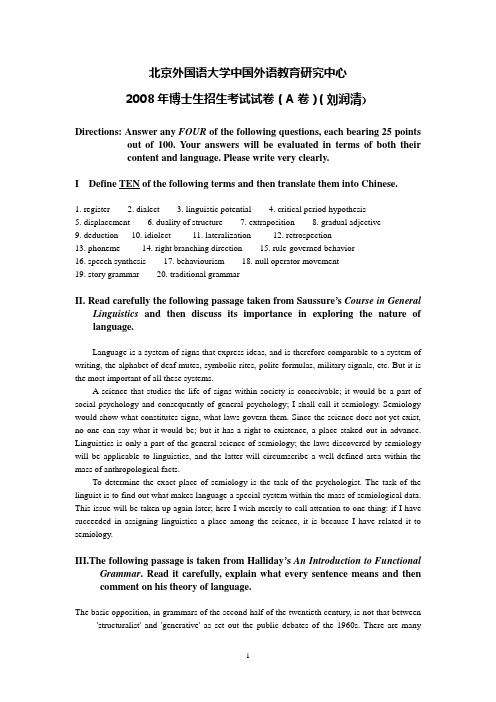
北京外国语大学中国外语教育研究中心2008年博士生招生考试试卷(A卷)(刘润清)Directions: Answer any FOUR of the following questions, each bearing 25 points out of 100. Your answers will be evaluated in terms of both theircontent and language. Please write very clearly.I Define TEN of the following terms and then translate them into Chinese.1. register2. dialect3. linguistic potential4. critical period hypothesis5. displacement6. duality of structure7. extraposition8. gradual adjective9. deduction 10. idiolect 11. lateralization 12. retrospection13. phoneme 14. right branching direction 15. rule-governed behavior16. speech synthesis 17. behaviourism 18. null operator movement19. story grammar 20. traditional grammarII. Read carefully the following passage taken from Saussure’s Course in General Linguistics and then discuss its importance in exploring the nature of language.Language is a system of signs that express ideas, and is therefore comparable to a system of writing, the alphabet of deaf-mutes, symbolic rites, polite formulas, military signals, etc. But it is the most important of all these systems.A science that studies the life of signs within society is conceivable; it would be a part of social psychology and consequently of general psychology; I shall call it semiology. Semiology would show what constitutes signs, what laws govern them. Since the science does not yet exist, no one can say what it would be; but it has a right to existence, a place staked out in advance. Linguistics is only a part of the general science of semiology; the laws discovered by semiology will be applicable to linguistics, and the latter will circumscribe a well-defined area within the mass of anthropological facts.To determine the exact place of semiology is the task of the psychologist. The task of the linguist is to find out what makes language a special system within the mass of semiological data. This issue will be taken up again later; here I wish merely to call attention to one thing: if I have succeeded in assigning linguistics a place among the science, it is because I have related it to semiology.III.The following passage is taken from Halliday’s An Introduction to Functional Grammar. Read it carefully, explain what every sentence means and then comment on his theory of language.The basic opposition, in grammars of the second half of the twentieth century, is not that between 'structuralist' and 'generative' as set out the public debates of the 1960s. There are manyvariables in the way grammars are written, and any clustering of these is bound to distort the picture; but the more fundamental opposition is between those that are primarily syntagmatic in orientation (by and large the formal grammars, with their roots in logic and philosophy) and those that are primarily paradigmatic (by and large the functional ones, with their roots in rhetoric and ethnography) The former interpret a language as a list of structures, among which, as a distinct second step, regular relationships may be established (hence the introduction of transformations); they tend to emphasize universal features of language, to take grammar (which they call syntax) as the foundation of language (hence the grammar is arbitrary), and so to be organized around the sentence. The later interpret a language as a network of relations, with structures coming in as the realization of these relationships; they tend to emphasize variables among different languages, to take semantics as the foundation (hence the grammar is natural) and so to be organized around the text, or discourse, There are many cross-currents, with insights borrowed from one to the other; but they are ideologically fairly different and it is often difficult to maintain a dialogue.IV. The following passage is take from Peter Barb's Word Play: What Happens When People Talk (1973). Read it carefully and then comment on linguistic relativity.Such a connection between language and thought is rooted in common-sense beliefs, but no one gave much attention to the matter before Wilhelm von Humboldt, the 19th century German philologist and diplomat. He stated that the structure of a language expresses the inner life of its speakers: "Man lives with the world abut him, principally, indeed exclusively, as language presents it." In this century, the case for a close relationship between language and reality was stated by Edward Sapir: "Human beings d not live in the objective world alone, nor alone in the world of social activity as ordinarily understood, but are very much at the mercy of the particular language which has become the medium for their society. …The fact of the matter is that the 'real world' is to a large extent built up on the language habits of the group. No two languages are ever sufficiently similar to be considered as representing the same social reality. The worlds in which different societies live are distinct worlds, not merely the same world with different labels attached."About 1932 one of Sapir's students at Yale, Benjamin Lee Whorf, drew on Sapir's ideas and began an intensive study of the language of the Hopi Indians of Arizona. Whorf's brilliant analysis of Hopi places common-sense beliefs about language and thought on a scientific basis -- and it also seemed to support the view that man is a prisoner of his language. Whorf concluded that language "is not merely a reproducing instrument for voicing ideas but rather is itself the shaper of ideas. … we dissect nature along lines laid down by our n ative languages."V. Please give the main content of Grice's Cooperative Principle with its four maxims explained and then discuss conversational implicatures of Group A (in which no maxim is violated), Group B (in which a maxim is violated), and Group C (in which a maxim is flouted by means of a figure of speech).VI. The following is a passage by Chomsky. Read it carefully and then discuss th edifference between Chomsky's theory of linguistics and other approaches in linguistics.Generative grammar arose in the context of what is often called “the cognitive revolution” of the 1950s, and was an important factor in its development. Whether or not the term “revolution” is appropriate, there was an important change of perspective: from the study of behavior and its products (such as texts), to the inner mechanisms that enter into thought and action. The cognitive perspective regards behavior and its products not as the object of inquiry, but as data that may provide evidence about the inner mechanisms of mind and the ways these mechanisms operate in executing actions and interpreting experience. The properties and patterns that were the focus of attention in structural linguistics find their place, but as phenomena to be explained along with innumerable others, in terms of the inner mechanisms that generate expressions. The approach is “mentalistic,” but in what should be an uncontroversial sense. It is concerned with “mental aspects of the world,” which stand alongside its mechanical, chemical, optical, an d other aspects. It undertakes to study a real object in the natural world—the brain, its states, and its functions—and thus to move the study of the mind toward eventual integration with the biological science. (Chomsky, N. 2000. New Horizons in the Study of Language and Mind)VII. The following is taken from Bloomfield's Language about the famous story of Jack and Jill which is often quoted to illustrate Bloomfield's behaviorism in linguistics. Read it carefully and discuss how Bloomfield explains the process of stimulus and response and point out where he is wrong.Suppose that Jack and Jill are walking down a lane. Jill is hungry. She sees an apple in a tree. She makes a noise with her larynx, tongue and lips. Jack vaults the fence, climbs the tree, take the apple, brings it to Jill, and places it in her hand. Jill eats the apple.This succession of events could be studies in many ways, but we, who are studying language, will naturally distinguish between the act of speech and the other occurrences, which we shall call practical events. Viewed in this way, the incident consists of three parts in order of time:A.Practical events preceding the act of speech.B.Speech.C.Practical events following the act of speech.We shall examine first the practical events: A and C. The events in A concern mainly the speaker, Jill. She was hungry; that is, some of her muscles were contracting, and some fluids were being secreted, especially in her stomach. Perhaps she was also thirsty; her tongue and throat were dry. The light-waves reflected from the red apple struck her eyes. She saw Jack by her side. Her past dealings with Jack should now enter into the picture; ket us suppose that they consisted in some ordinary relation, like that of brother and sister or that of husband and wife. All these events, which precede Jill's speech and concern her, we call the speaker's stimulus.We now turn to C, the practical events which came after Jill's speech. These concern mainly the hearer, Jack, and consist of his fetching the apple and giving it to Jill. The practical events which follow the speech and concern the hearer, we call the hearer's response. The events which follow the speech concern also Jill, and this in very important way: she gets the apple into her grasp and eats it.。
英语语言博士试题及答案

英语语言博士试题及答案一、选择题(每题2分,共20分)1. The word "phenomenon" is most closely related to which of the following?A. PhenomenaB. PhenomenalC. PhenomenonD. Phenomenology2. Which of the following is NOT a characteristic of the English language?A. FlexibilityB. Global reachC. Limited vocabularyD. Rich in idiomatic expressions3. The concept of "semantics" in linguistics refers to the:A. Study of language soundsB. Study of language meaningsC. Study of language structureD. Study of language change4. The term "morphology" is associated with the study of:A. Word formationB. Sentence structureC. Language acquisitionD. Language change over time5. In the context of sociolinguistics, "code-switching" refers to:A. Switching between different languagesB. Changing the tone of voiceC. Using different dialectsD. Alternating between formal and informal language6. The "phoneme" is the smallest unit of sound that can:A. Change the meaning of a wordB. Be heard by the human earC. Be written downD. Be pronounced by a speaker7. "Pragmatics" is the study of:A. The meaning of words in a sentenceB. The context in which language is usedC. The rules of grammarD. The physical properties of speech sounds8. The "passive voice" in English is used to:A. Emphasize the actionB. Emphasize the receiver of the actionC. Describe the action in detailD. Highlight the time of the action9. "Syntactic ambiguity" occurs when a sentence can be:A. Heard in different waysB. Written in different waysC. Interpreted in more than one wayD. Pronounced in different ways10. The term "register" in linguistics refers to:A. A specific languageB. A specific style of language useC. A specific set of vocabularyD. A specific set of grammar rules二、简答题(每题10分,共30分)1. Explain the difference between "prescriptive" and "descriptive" approaches in linguistics.2. Describe the process of language acquisition in children and the role of "input" and "interaction" in this process.3. Discuss the impact of globalization on the English language, including the emergence of new varieties and the spread of English as a global lingua franca.三、论述题(每题25分,共50分)1. Analyze the role of language in shaping cultural identity and the challenges faced by minority languages in a globalized world.2. Discuss the principles of translation and the challenges of translating literary works from one language to another, including the issues of cultural context and idiomatic expressions.四、案例分析题(共30分)Analyze the following dialogue between two speakers, identifying the use of language, the social context, and the implications of their conversation.Speaker A: "You know, I've been thinking about moving to a new city. I hear the job opportunities are great there." Speaker B: "Oh, really? But don't you think you'll miss your family and friends? And what about the cultural differences?"答案:一、选择题1. A2. C3. B4. A5. A6. A7. B8. B9. C10. B二、简答题1. Prescriptive linguistics focuses on the "correct" use of language and often seeks to enforce rules, while descriptive linguistics aims to describe how language is actually used by speakers without making judgments about correctness.2. Language acquisition in children is a natural process that involves exposure to language (input) and interaction with caregivers and peers. Input provides the child withlinguistic data, while interaction helps the child to understand the social and communicative functions of language.3. Globalization has led to the spread of English as a global lingua franca, facilitating international communication and trade. It has also resulted in the emergence of new varieties of English, such as World Englishes, which are influenced by local languages and cultures.三、论述题1. Language is a fundamental part of cultural identity, shaping how individuals perceive themselves and their placein the world. Minority languages face challenges such as language shift, where speakers adopt the dominant languagefor economic or social reasons, and a lack of resources and recognition, which can lead to language endangerment or extinction.2. Translation。
语言学理论考博试题
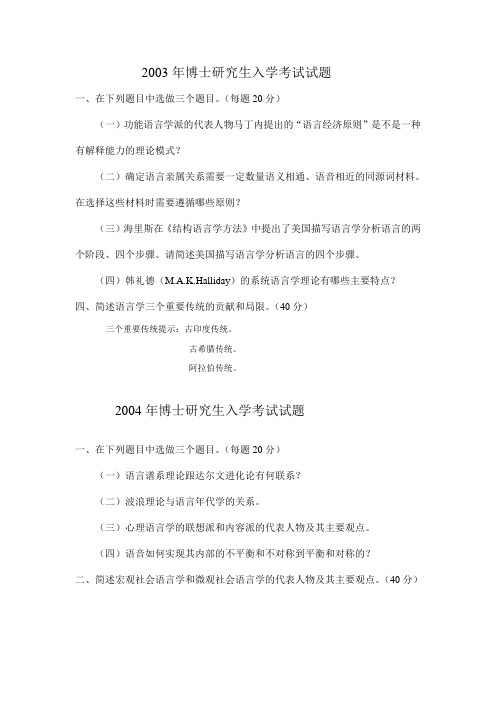
2003年博士研究生入学考试试题一、在下列题目中选做三个题目。
(每题20分)(一)功能语言学派的代表人物马丁内提出的“语言经济原则”是不是一种有解释能力的理论模式?(二)确定语言亲属关系需要一定数量语义相通、语音相近的同源词材料。
在选择这些材料时需要遵循哪些原则?(三)海里斯在《结构语言学方法》中提出了美国描写语言学分析语言的两个阶段、四个步骤。
请简述美国描写语言学分析语言的四个步骤。
(四)韩礼德(M.A.K.Halliday)的系统语言学理论有哪些主要特点?四、简述语言学三个重要传统的贡献和局限。
(40分)三个重要传统提示:古印度传统。
古希腊传统。
阿拉伯传统。
2004年博士研究生入学考试试题一、在下列题目中选做三个题目。
(每题20分)(一)语言谱系理论跟达尔文进化论有何联系?(二)波浪理论与语言年代学的关系。
(三)心理语言学的联想派和内容派的代表人物及其主要观点。
(四)语音如何实现其内部的不平衡和不对称到平衡和对称的?二、简述宏观社会语言学和微观社会语言学的代表人物及其主要观点。
(40分)中央民族大学2005年博士学位研究生入学考试试题(215语言学理论与方法)(所有答案均写在答题纸上,写在试卷上无效)A卷一、名词解释(20分。
从6个小题中选做4题,每小题各5分)(一)联想关系(二)共时研究与历时研究(兼谈二者的关系)(三)语言联盟(四)语言规划(五)替换分析法(六)语域二、简述题(50分)(一)什么是格里姆定律?什么是维尔纳定律?二者有何关系?简要说明后者在欧洲语言学领域中所产生的影响。
(20分)(二)简要论述马尔丁内的“语言经济原则”。
(20分)(三)伦敦学派在音位学理论方面有哪些贡献?(20分)(从以上3小题中选答两题)(四)简要论述语音学和音位学的区别。
(10分)(五)简要论述乔姆斯基的理论在心理语言学方面的贡献。
(10分)(从以上两个小题中选做一题)三、论述题:(30分,从下列两小题中选做一题)(一)试述人类语言学的主要理论和研究方法以及20世纪中期以来我国语言学界在这方面所做的工作。
南京师范大学外国语学院考博真题
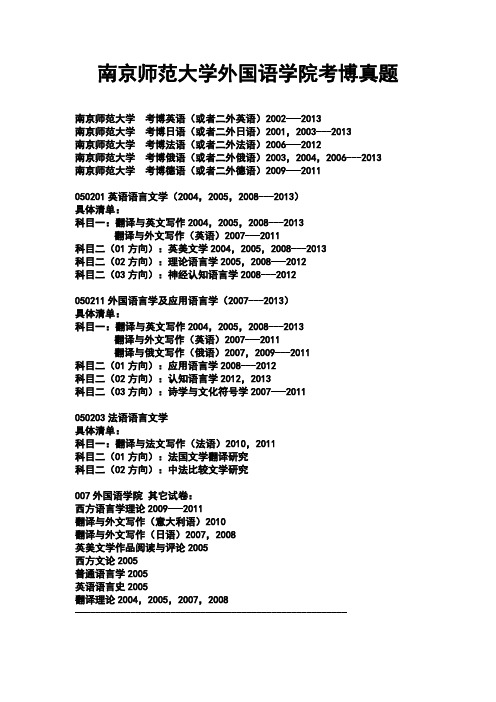
南京师范大学外国语学院考博真题南京师范大学考博英语(或者二外英语)2002---2013南京师范大学考博日语(或者二外日语)2001,2003---2013南京师范大学考博法语(或者二外法语)2006---2012南京师范大学考博俄语(或者二外俄语)2003,2004,2006---2013南京师范大学考博德语(或者二外德语)2009---2011050201英语语言文学(2004,2005,2008---2013)具体清单:科目一:翻译与英文写作2004,2005,2008---2013翻译与外文写作(英语)2007---2011科目二(01方向):英美文学2004,2005,2008---2013科目二(02方向):理论语言学2005,2008---2012科目二(03方向):神经认知语言学2008---2012050211外国语言学及应用语言学(2007---2013)具体清单:科目一:翻译与英文写作2004,2005,2008---2013翻译与外文写作(英语)2007---2011翻译与俄文写作(俄语)2007,2009---2011科目二(01方向):应用语言学2008---2012科目二(02方向):认知语言学2012,2013科目二(03方向):诗学与文化符号学2007---2011050203法语语言文学具体清单:科目一:翻译与法文写作(法语)2010,2011科目二(01方向):法国文学翻译研究科目二(02方向):中法比较文学研究007外国语学院其它试卷:西方语言学理论2009---2011翻译与外文写作(意大利语)2010翻译与外文写作(日语)2007,2008英美文学作品阅读与评论2005西方文论2005普通语言学2005英语语言史2005翻译理论2004,2005,2007,2008------------------------------------------------------。
北京语言大学考博英语真题及其解析

北京语言大学考博英语真题及其解析Directions:You are going to read a list of headings and a text aboutpreparing in the academic community.Choose the most suitable headingfrom the list A-G for each numbered paragraph(41-45).The first andlast paragraphs of the text are not numbered.There is one extraheading which you do not need to use.Mark your answers on ANSWER SHEET1.(10points)Long before Man lived on the Earth,there were fishes,reptiles,birds,insects,and some mammals.Although some of these animals wereancestors of kinds living today,others are now extinct,that is,theyhave no descendants alive now.41Very occasionally the rocks show impression of skin,so that,apart from color,we can build up a reasonably accurate picture ofan animal that died millions of years ago.That kind of rock in whichthe remains are found tells us much about the nature of the originalland,often of the plants that grew on it,and even of its climate.42Nearly all of the fossils that we know were preserved in rocksformed by water action,and most of these are of animals that livedin or near water.Thus it follows that there must be many kinds ofmammals,birds,and insects of which we know noting.Geng duo yuan xiaowan zheng kao bo ying yu zhen ti ji qi jie xi qing lian xi quan guomian fei zi xun dian hua:si ling ling liu liu ba liu jiu qi ba,huojia zi xun qq:qi qi er liu qi ba wu san qi.43There were also crablike creatures,whose bodies were coveredwith a horny substance.The body segments each had two pairs of legs, one pair for walking on the sandy bottom,the other for swimming.The head was a kind of shield with a pair of compound eyes,often with thousands of lenses.They were usually an inch or two long but some were2feet.44Of these,the ammonites are very interesting and important.They have a shell composed of many chambers,each representing a temporary home of the animal.As the young grew larger it grew a new chamber and sealed off the previous one.Thousands of these can be seen in the rocks on the Dorset Coast.45About75million years ago the Age of Reptiles was over and most of the groups died out.The mammals quickly developed,and we can trace the evolution of many familiar animals such as the elephant and horse.Many of the later mammals though now extinct,were known to primitive man and were featured by him in cave paintings and on bone carvings.[A]The shellfish have a long history in the rock and many different kinds are known.[B]Nevertheless,we know a great deal about many of them because their bones and shells have been preserved in the rocks as fossils, from them we can tell their size and shape,how they walked,the kind of food they ate.[C]The first animals with true backbones were the fishes,first known in the rocks of375million years ago.About300million yearsago the amphibians,the animals able to live both on land and in water, appeared.They were giant,sometimes8feet long,and many of them lived in the swampy pools in which our coal seam,or layer is formed. The amphibians gave rise to the reptiles and for nearly150million years these were the principal forms of life on land,in the sea,and in the air.[D]The best index fossils tend to be marine creatures.These animals evolved rapidly and spread over large over large areas of the world.[E]The earliest animals whose remains have been found were all very simple kinds and lived in the ter forms are more complex, and among these are the sea lilies,relations of the star fishes, which had long arms and were attached by a long stalk to the sea bed, or to rocks.[F]When an animal dies,the body,its bones,or shell,may often be carried away by streams into lakes or the sea and there get covered up by mud.If the animal lived in the sea its body would probably sink and be covered with mud.More and more mud would fall upon it until the bones or shell become embedded and preserved.[G]Many factors can influence how fossils are preserved in rocks. Remains of an organism may be replaced by minerals,dissolved by an acidic solution to leave only their impression,or simply reduced to a more stable form.答案详解41.【解析】[B]从试题前后的语义逻辑关系来看,试题前面的一段话表明的信息是Although some of these animals were ancestors of kinds living today,others are now extinct,that is,they have no descendants alive now(尽管这些动物是某些活到现在的物种的祖先,但有的动物却灭绝了,也就是说它们现在已经没有子孙后代活在这个世界上)。
中文系考博考试题及答案
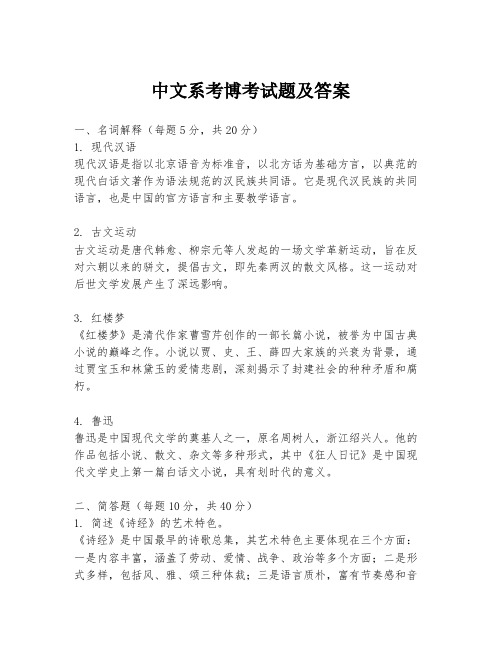
中文系考博考试题及答案一、名词解释(每题5分,共20分)1. 现代汉语现代汉语是指以北京语音为标准音,以北方话为基础方言,以典范的现代白话文著作为语法规范的汉民族共同语。
它是现代汉民族的共同语言,也是中国的官方语言和主要教学语言。
2. 古文运动古文运动是唐代韩愈、柳宗元等人发起的一场文学革新运动,旨在反对六朝以来的骈文,提倡古文,即先秦两汉的散文风格。
这一运动对后世文学发展产生了深远影响。
3. 红楼梦《红楼梦》是清代作家曹雪芹创作的一部长篇小说,被誉为中国古典小说的巅峰之作。
小说以贾、史、王、薛四大家族的兴衰为背景,通过贾宝玉和林黛玉的爱情悲剧,深刻揭示了封建社会的种种矛盾和腐朽。
4. 鲁迅鲁迅是中国现代文学的奠基人之一,原名周树人,浙江绍兴人。
他的作品包括小说、散文、杂文等多种形式,其中《狂人日记》是中国现代文学史上第一篇白话文小说,具有划时代的意义。
二、简答题(每题10分,共40分)1. 简述《诗经》的艺术特色。
《诗经》是中国最早的诗歌总集,其艺术特色主要体现在三个方面:一是内容丰富,涵盖了劳动、爱情、战争、政治等多个方面;二是形式多样,包括风、雅、颂三种体裁;三是语言质朴,富有节奏感和音乐美。
2. 论述唐代诗歌的发展历程。
唐代诗歌经历了初唐、盛唐、中唐、晚唐四个阶段。
初唐时期,诗歌以宫廷诗为主,风格华丽;盛唐时期,诗歌题材广泛,风格豪放,以李白、杜甫为代表;中唐时期,诗歌转向现实主义,以白居易、元稹为代表;晚唐时期,诗歌风格多样,以李商隐、杜牧为代表。
3. 分析《水浒传》中宋江的形象。
宋江是《水浒传》中的主要人物之一,他的形象具有复杂性。
一方面,他具有忠义之心,关心百姓疾苦,有强烈的正义感;另一方面,他也有软弱和妥协的一面,最终导致梁山好汉的悲剧结局。
4. 简述五四新文化运动对现代文学的影响。
五四新文化运动是20世纪初的一场思想解放运动,它对现代文学产生了深远影响。
首先,它提倡白话文,推动了文学语言的现代化;其次,它倡导民主和科学,促进了文学思想的更新;最后,它鼓励文学创新,为现代文学的发展奠定了基础。
2022年中国传媒大学考博语言学及应用语言学试题及答案

2022年中国传媒大学考博语言学及应用语言学试题及答案中国传媒大学2022年攻读博士学位研究生入学考试语言学理论试题一.论述题1.必答题(40分)就近年来语言生活中新出现的现象尽你所知进行论述。
2.选答题(30分,任选其一回答)A.就语言中的歧义现象进行论述。
B.就话语标记研究进行论述。
二.分析题(30分,每小题10分)1.请就下面一则对话谈谈你对“意义”的理解。
【情景:母亲带着孩子在动物园看老虎。
】母亲:孩子别太靠近笼子了。
孩子:妈妈,你放心,我不会伤害老虎的。
2.请从社会文化角度分析下面两组汉英对应的成语。
3.尽可能全面地分析下面句子中的“跟”的词性、功能与意义。
现在很明白,我跟他两个人中,你只能跟一个,你现在就决定吧,究竟你跟谁,请你跟我说清楚。
中国传媒大学2022年攻读博士学位研究生入学考试语言学理论(答案)三.论述题1.必答题(40分)就近年来语言生活中新出现的现象尽你所知进行论述。
①恢复繁体字的争论。
近年来,两会上,多次出现恢复繁体字的呼声,一些学者如季羡林等认为繁体字承载了几千年来中华文明。
苏培成、任继愈等支持简体者认为汉字简化是实际需要造成的,是群众需要造成的恢复繁体字是不可能的。
最后经过几次重大的讨论,形成了一个比较客观和中肯的看法,既不必坚持认为繁体就好,又能客观的支出简化字的若干不足,繁体字有其文化传承的价值,但简化字并没有割裂文化,简化字是汉字文化的和汉字发展的一个部分。
②人名用字的讨论。
1、关于生僻字取名的问题,能不能用生僻字取名,近几年来争论不断,有的生僻字计算机不能识别,对于户籍管理和日常应用带来很大不便。
2、赵C起名事件。
赵c的名字用了二十多年,但在办理第二代身份证的时候,进不了公安部户籍管理程序,被要求改名,赵c不肯改名,把江西市鹰潭公安局告上法庭,但法律要求的居民身份证登记要素未包含英文字母。
最后结果是协商改名。
3、思考:亟需出台相关的姓名条例。
3.地名中的“复古风”:地名文化遗产保护与地名规范问题。
2021年中国传媒大学考博语言学及应用语言学试题及答案

2021年中国传媒大学考博语言学及应用语言学试题及答案2021博士入学考试语言学理论答题说明:答案一律写在答题纸上,不需抄题,标明题号,答在试题上无效。
一、论述题:1、必答题(40分)就语言和思维的关系尽你所知进行论述。
2、选答题(30分,任选其一进行回答)A、就语境理论对语言研究的作用尽你所知进行论述。
B、就语言的组合关系和聚合关系尽你所知进行论述。
二、分析题(30分,每小题10分)1、列出下列语言片段的变换矩阵,分析他们的异同及原因。
台上坐着主席。
台上摆着鲜花。
台上演着京戏。
2、电视连续剧《阿童木》中把世界毁灭的日子定在13日13点13分13秒,请从文化语言学的角度作出说明。
3、下列句子中状语的语义指向相同吗?他(喜滋滋地)炸了盘花生米。
他(早早地)炸了盘花生米。
他(脆脆的)炸了盘花生米。
2021博士入学考试语言学理论答题说明:答案一律写在答题纸上,不需抄题,标明题号,答在试题上无效。
一、论述题:1、必答题(40分)就语言和思维的关系尽你所知进行论述。
答: (一)历代关于语言和抽象思维关系的见解1、古希腊哲学家柏拉图主张思维和语言一致;亚里士多德主张思维和语言有联系但不是一个东西。
荀子《正名篇》:“约定俗成谓之宜”;王充《论衡》“口言以明志”,“情见于辞,意验于言。
”2、中世纪的“唯理普遍语法”,是语言和逻辑不分。
认为“人类的逻辑思维是共同的,语法也应该是共同的。
”3、近代黑格尔认为发音器官的最终形成,语音的产生对语言和思维的产生有重大意义。
(二)19世纪中叶到20世纪50年代,有过三次关于语言和思维的论争,争论的核心仍是围绕传统的两种见解:“=”还是“≠”。
1、第一次论争在19世纪50―70年代,蒲鲁东认为:语言=思维=现实;杜林认为:真正的思维抽象的思维是不在语言的基础上进行的。
马克思对蒲鲁东、恩格斯对杜林都做了批评,主张“思维必须以语言作为物质外壳”,“思维和语言既有联系又有区别”。
2、第二次论争是在20世纪30-50年代。
国际汉语教育专业考博试题

选择题:在国际汉语教育中,下列哪项不是汉语作为第二语言教学的基本原则?A. 以学生为中心B. 注重语言交际能力的培养C. 严格遵循语法翻译法(正确答案)D. 充分利用多媒体教学资源下列哪项不是国际汉语教师需要具备的基本素质?A. 扎实的汉语语言学基础B. 跨文化交际能力C. 精通多国语言(正确答案)D. 良好的教学组织与管理能力在国际汉语教学中,下列哪项不是常用的教学方法?A. 任务型教学法B. 情境教学法C. 单纯语法讲解法(正确答案)D. 合作学习法下列哪项不是国际汉语教育专业考博时可能涉及的领域?A. 汉语国际教育理论与实践B. 第二语言习得理论C. 世界文学史(正确答案)D. 跨文化交际与文化传播在国际汉语教学中,关于词汇教学,下列哪项不是有效的策略?A. 利用语境进行词汇教学B. 通过游戏和竞赛活动教授词汇C. 死记硬背词汇表(正确答案)D. 结合文化元素进行词汇教学下列哪项不是国际汉语教育专业考博时可能考察的语言学理论知识?A. 语音学B. 句法学C. 地理语言学(正确答案)D. 语义学在国际汉语教学中,关于文化教学,下列哪项不是重要的内容?A. 中国传统文化介绍B. 当代中国社会与文化C. 外国文化对比与分析(正确答案)D. 跨文化交际技巧下列哪项不是国际汉语教育专业考博时可能要求的科研能力?A. 能够独立进行汉语国际教育相关研究B. 能够撰写并发表高质量的学术论文C. 精通计算机编程技术(正确答案)D. 能够参与或主持科研项目在国际汉语教学中,关于课堂教学管理,下列哪项不是有效的策略?A. 建立良好的师生关系B. 制定并执行课堂纪律C. 忽视学生的个体差异(正确答案)D. 灵活运用多种教学方法和手段。
- 1、下载文档前请自行甄别文档内容的完整性,平台不提供额外的编辑、内容补充、找答案等附加服务。
- 2、"仅部分预览"的文档,不可在线预览部分如存在完整性等问题,可反馈申请退款(可完整预览的文档不适用该条件!)。
- 3、如文档侵犯您的权益,请联系客服反馈,我们会尽快为您处理(人工客服工作时间:9:00-18:30)。
2007年中国人民大学语言学及应用语言学考博试题
语言学理论(100分)
1.配价理论中的“配价”的性质,有人说其属于语法范畴,有人说其属于语义范畴,还有
人说其属于句法——语义范畴,你的看法是什么?(30分)
2.如何看待社会语言学所提出的“共时的变异反映历时的发展?”(30分)
3.如何看待留学生的语言错误,对“有错必纠”和“有错不纠”有何看法?(40分)
4.说说形式主义语言学、功能语言学、认知语言学的主张和特点(40分)
汉语语法分析(100分)
1.词语的再分类与句法分析的关系。
(30分)
2.对“我偷了他一本书”这种句型如何看待,是双宾句还是单宾句,你的看法是什么?(30
分)(打碎了他三个杯子)
3.N1VN2(如“服装加工厂”和“汽车修理厂”)这种名词结构,有人说N1是V的前置
宾语,有人说N1是受事成分,但是都有例外。
请你以此为研究对象,写一个论文提纲,包括研究的目的、方法和步骤等。
(40分)
2008年人民大学语言学及应用语言学考博专业课试题
语言学理论
1.结合汉语实际论述语法形式和语法意义之间的关系(30分)
2.结合汉语实际论述语言变异和语言变化的关系(30分)
3.对外汉语教学方向选做第一题:
(1)试论功能语言学对对外汉语教学的启发和影响(40分)
(2)现代汉语中,934个汉字就能占到常用汉字的90%以上,那么如果掌握了这934个汉字,是不是就可以读懂书刊、报纸、网页等90%以上的内容呢?
汉语语法分析:
1.试论语法单位的同一性以及对词类划分的影响(30分)
2.结合汉语实际,试论“语义指向”在现代汉语语法中的应用(30分)
3.现代汉语中,常常说“时间还早着呢”,“她还小着呢”,却不能说“*时间还晚着呢”,“*她还大着呢”,为什么?
人大2009现代汉语专业试题
语言学理论
1.探探你对“任意性”与“象似性”的认识(30分)
2.为什么说变异理论是社会语言学最有价值的理论(30分)
3.选做题(40)
(1)谈谈结构主义、认知语言学、功能主义理论对对外汉语教学的启发。
(2)结合语言实际,谈谈语言接触与语言演变发展的关系。
汉语语法分析:
1.结合汉语实际,谈谈变换分析的基本原理、作用及其局限(20分)
2.结合现代汉语实际,谈谈句法成分话题化过程中受到的句法语义限制(40分)
3.下面这些【一N】前后呼应的格式,能否归纳成几个不同的类型,概括其格式义(40
分)
(1)睁一只眼,闭一只眼。
(2)买一个送一个
(3)一年不如一年
(4)一个比一个调皮
(5)一分钱一分货
(6)一个萝卜一个坑
(7)一人一个主意
(8)一步一个脚印
(9)一人一间
(10)一天一个样儿。
2008年北京大学对外汉语教育学院考博专业课试题
专业课(七选五)
1.简述配价语法的基本观点并谈一谈其在对外汉语教学中的应用价值。
2.语言习得研究的发展脉络。
3.介绍一个国外教学标准(美国21世界外语学习的目标或欧盟语言框架)并谈一谈
其对汉语教学的启发意义。
4.谈一谈汉语拼音方案的作用和问题及如何处理方案的为题,将之灵活运用于教学的
策略。
5.你觉得是否应该为外国人编写文化教材?为什么?
6.谈一谈关于词汇本体研究和教学的接口问题。
7.简述副词的相关研究及其关于副词教学的问题。
基础课(六选四)
1.对外汉语教学学科的体系有哪些?并选择一至两个方面,详述相关研究的发展。
2.简述三个平面理论的基本观点并谈一谈其在对外汉语教学中的应用价值。
3.谈一谈你对汉语本体研究与教学语法的关系的理解。
4.影响汉语语音习得的有哪些因素?
5.谈一谈跨文化交际与对外汉语教学的关系?
6.有观点认为“词汇具有开放性,词汇的系统性也不强,因此在汉语教学中不适宜系统进
行词汇教学”,你怎么看这种观点。
2010年北京大学对外汉语教育学院考博试题
专业:语言学及应用语言学
【对外汉语专业基础课】
考试时间:2010年3月13日8:30——11:30(共5题,每个20分)
1.对外汉语学科都有哪些研究领域,请选择两个方面介绍主要研究成果。
2.请评述近三十年来对外汉语教学方法的发展。
3.请评述近十年来副词研究的主要成果。
4.在对外汉语教学中,语言教学与文化教学是否具有同一性?请举实例说明。
5.第二语言测试的类型都有哪些?每种类型的测试在第二语言教学中的作用是什么?
【对外汉语专业课】
考试时间:2010年3月13日14:00——17:00
(媒体20分,1-3为必答题,4-6中任选两道作答)
1.请论述对外汉语语法教学的主要成果以及所面临的挑战。
2.对外汉语教学中的语音训练产生的舞蹈都有哪些?纠正方法是什么?
3.请从理论与实践两方面分别论述在对外汉语教学中,语言类教材与文化类教材在跨文化
交际中所发挥的作用。
4.简要介绍影响沐浴前一的因素都有哪些。
5.词汇量被认为是第二语言学习者提高语言能力的瓶颈,请论述有关词汇量的研究成果。
6.请选择一个中外研究语言与文化关系的名家,论述其研究观点及成果。
2007年中国传媒大学语言学及应用语言学考博试题
理论语言学
1.请就语言规划或语言规范化研究尽你所知展开论述(40分)
2.一下两题任选一道作答(30分)
A 请论述话语(鱼片活篇章)的研究
B 论述形式主义语言学与功能主义语言学的区别
3.分析题(3*30)
A请分析下面三个四字格短语的联系,并分析造成这种区别的原因以及每个短语的表达效果。
喜鹊登枝喜上梅梢喜上眉梢
B 请从认知的角度解释为什么“我后悔这件事了”能变换为“这件事后悔死我了”二
“我后悔这件事”不能变换成“这件事后悔我了”?
C 运用语预设理论分析下面这句话:北京又开始打击非法一日游了。
应用语言学的历史理论
1.请论述学习和研究应用语言学历史的主要意思和方法(40分)
2.请结合汉语史著作论述语言文字对于社会的应用(30分)
3.请论述语言学中预测方法(30分)
4.请论述结构语言学与社会语言学的歧异(30分)
北京大学2012年考博真题-理论语言学(回忆版)专业一:理论语言学1、提取语素有哪些方法?试对这些方法加以分析和评论。
2、提取词有哪些方法?试对这些方法加以分析和评论。
3、试评论索绪尔的符号线性理论。
4、汉语中主要有哪几种语义格?各家主要有什么分歧?难点在哪里?专业二:汉语、语言比较和对比1、划分词类的难点是什么?有哪些方法?你对这些方法有什么评价?2、判定两种语言有同源关系需要哪几个步骤?你认为当前对语源关系的研究中存在哪些问题?3、判定一句话中有几个音节有哪些方法?请你对这些方法加以评论。
4、上古音中的声母和韵母是通过什么方法得到的?请你对这些方法加以评论。
2010年吉林大学语言学考博试题
考博最新真题,我今天刚考完的。
供大家参考。
语言学综合卷共四道大题,分别是: 1. 美国“描写主义”的贡献与不足(20分)2. 如何看待语言的结构和功能(20分)3. 论“关系决定价值”(30分) 4. 词类的本质及划分词类的可行性(30分)。
